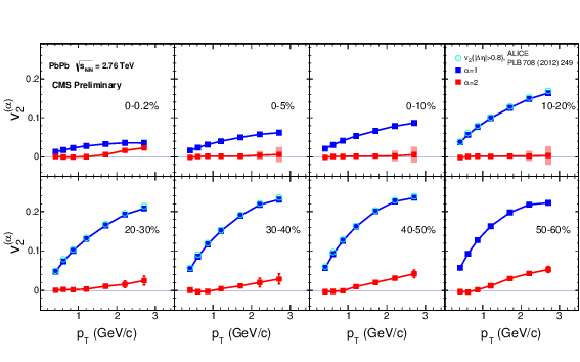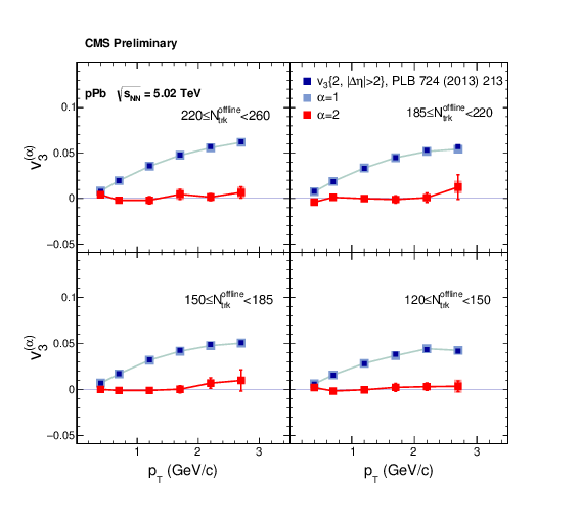

Compact Muon Solenoid
LHC, CERN
| CMS-PAS-HIN-15-010 | ||
| Principal component analysis of two-particle azimuthal correlations in PbPb and pPb collisions at CMS | ||
| CMS Collaboration | ||
| September 2015 | ||
| Abstract: A Principle Component Analysis (PCA) of two-particle azimuthal correlations as a function of transverse momentum ($p_{\mathrm T}$) is presented in PbPb collisions at 2.76 TeV and high-multiplicity pPb collisions at 5.02 TeV. The data were recorded using the CMS detector at the LHC. It has recently been shown that factorization breaking of two-particle azimuthal correlations can be attributed to the effect of initial-state fluctuations. Using a PCA approach, Fourier coefficients of observed two-particle azimuthal correlations as a function of both particles $p_{\mathrm T}$ are characterized into leading and sub-leading mode terms. The leading modes are essentially equivalent to anisotropy harmonics ($v_n$) previously extracted from two-particle correlation methods as a function of $p_{\mathrm T}$. The sub-leading modes represent the largest sources of factorization breaking. In the context of hydrodynamic models, they are a direct consequence of initial-state fluctuations, particularly providing new insights on the radial excitations of initial-state eccentricity. The results are presented over a wide range of centrality and event multiplicity. Connection to the measurement of $p_{\mathrm T}$-dependent flow factorization breaking is also discussed. | ||
|
Links:
CDS record (PDF) ;
CADI line (restricted) ; Figures are also available from the CDS record. These preliminary results are superseded in this paper, PRC 96 (2017) 064902. The superseded preliminary plots can be found here. |
||
| Figures | |

png ; pdf |
Figure 1:
First ($\alpha =1$) and second ($\alpha =2$) mode for $n=2$ as a function of $p_{\mathrm T}$ measured in high-multiplicity pPb collisions at $\sqrt {s_{NN}} =$ 5.02 TeV. The results for the first mode ($\alpha =1$) are compared to the standard elliptic flow magnitude taken from [23]. The thin error bars correspond to statistical uncertainties and wide to systematic. |

png ; pdf |
Figure 2:
First ($\alpha =1$), second ($\alpha =2$) and the third ($\alpha =3$) mode for n=2 as a function of $p_T$ measured in a wide centrality range of PbPb collisions at $\sqrt {s_{NN}}$=2.76 TeV. The results for the first mode ($\alpha =1$) are compared to the standard elliptic flow magnitude measured by the ALICE collaboration using the two-particle correlation method taken from [5]. The thin error bars correspond to statistical uncertainties and wide to systematic. |

png ; pdf |
Figure 3:
First ($\alpha =1$) and second ($\alpha =2$) mode for $n=3$ as a function of $p_{\mathrm T}$ measured in high-multiplicity pPb collisions at $\sqrt {s_{NN}} =$ 5.02 TeV. The results for the first mode ($\alpha =1$) are compared to the standard triangular flow magnitude taken from [23]. The thin error bars correspond to statistical uncertainties and wide to systematic. |

png ; pdf |
Figure 4:
First ($\alpha =1$) and second ($\alpha =2$) mode for $n=2$ as a function of $p_{\mathrm T}$ measured in a wide centrality range of PbPb collisions at $\sqrt {s_{NN}} =$ 2.76 TeV. The results for the first mode ($\alpha =1$) are compared to the standard triangular flow magnitude measured by the ALICE collaboration using the two-particle correlation method taken from [5]. The thin error bars correspond to statistical uncertainties and wide to systematic. |

|
Compact Muon Solenoid LHC, CERN |

|

|

|

|

|

|